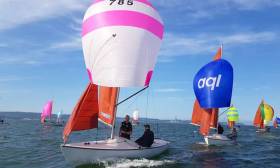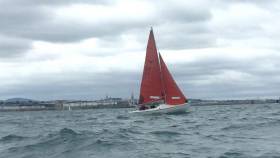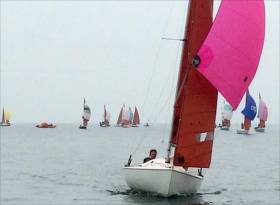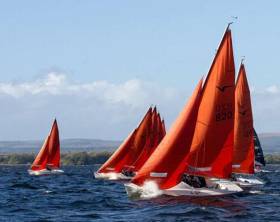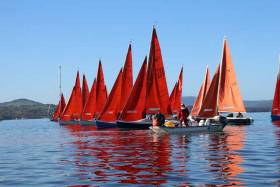Displaying items by tag: squib
Lough Derg Yacht Club Expects Record Entry from Squibs, Flying Fifteens & SB20s for Freshwater Championships
Lough Derg Yacht Club is hosting its annual keelboat regatta on the weekend of the 11th and 12th of October. The event will be a wrap up to the season for many of the competitors and over 50 entries are expected from three classes - making it one of the biggest sailing events of the year on the Shannon.
The big attraction for many sailors is the beautiful autumnal setting of Lough Derg but also the opportunity to thoroughly wash the boat out in freshwater at the end of the season.
The Squibs will be welcoming visitors from the UK as well as Belfast, Strangford Lough, Howth, Kinsale and Dun Laoghaire. As Afloat reported earlier, Kinsale Yacht Club will be promoting their UK and Irish Nationals which are being held in June 2020.
Irish Sailing President Jack Roy and his daughter Jill have indicated they will compete as will UK champion Dick Batt. Squib stalwart Vincent Delany, second in the recent Irish Nationals, is also sailing as is Irish Champions Gordon Patterson and Ross Nolan from Royal North.
The SB20s have just announced that the Irish Nationals will be hosted in Lough Ree in Sept 2020 and a good fleet is expected - including Lough Derg and Lough Ree entries.
The Flying Fifteen fleet, who have just completed a World Championship in Dun Laoghaire are also reported to be travelling to Dromineer in numbers, just a week after the class hosts the All Ireland Sailing Championships at the National Yacht Club. It may be the only winter sailing for the FF's at Dun Laoghaire Harbour given the current winter hard standing woes currently in place.
Unfortunately, the Dragons this year are not competing due to 90th birthday celebrations in Italy where nine Irish boats are competing.
Day 1 of the 50th Anniversary Squib Irish National Championships at Royal North of Ireland Yacht Club on Belfast Lough had all the hallmarks of champagne sailing, sun out, blue skies and a steady breeze but only for a few more knots to make it perfection. First round the windward mark was 601 Squiblet, sailed by Ian McMillan & Laura Fitzgerald, with Fagin and Inshallah and Outlaw close behind. Race one finished, Fagin 1st, Inshallah 2nd and Outlaw 3rd.
Race 2 took a little while to get under way after a brief postponement and general recall. The black flag was up and unfortunately, Fagin got caught out along with Lil Quickie and Born Wild. This time it was Outlaw, Prodigal, Firecracker and Femme Fatale, fighting it out at the front, Inshallah was showing great boat speed and managed to pull through the fleet to take 3rd from Femme. At the finish, it was Outlaw, Firecracker.
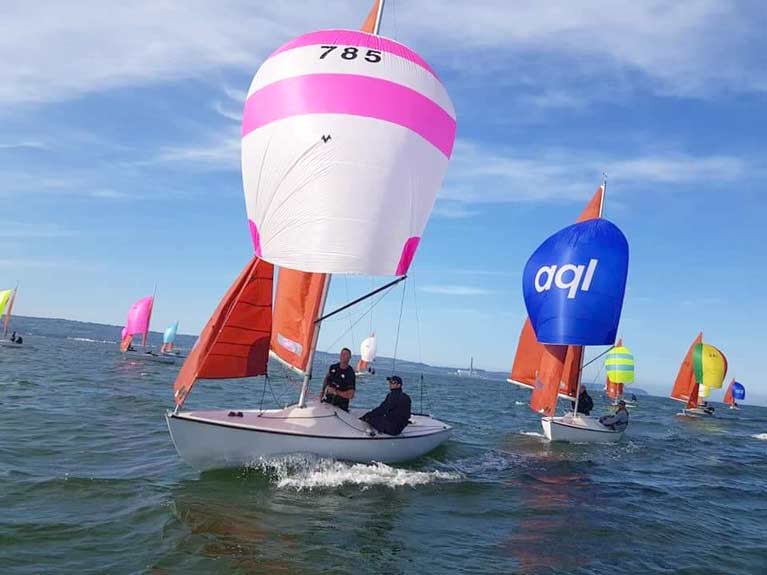
Race 3, The race started in a light and shifty SE breeze, the fleet were away clean and, in true Holywood style, the underdog came good; Vincent Delaney and Joe O'Byrne had the bit between their teeth and sailed away from the fleet, with Inshallah showed amazing boat speed to pull through the fleet into 2nd and Maximus holding onto 3rd.
Race 4 started in similar breeze and direction but getting even more shifty, Prodigal, sailed by father and son duo Greg and Harry Bell, led round the windward mark. Again, as in any fairytale, Femme Fatale showing speed had a blinder and took the win, with Fagin 2nd and Outlaw 3rd.
Race 5. After a short postponement and movement of the committee boats to go and find the breeze, the race got under way in marginal racing conditions, Maximus lead round the first mark to later find out they had been Black-flagged after a very taxing run in little the fleet went inside out. At the finish it was Fagin making the most of the light, shifty conditions taking the win and Worm having a great race, sailed by Sam Lyness and Eric Heyes and Volante, sailed by Simon Watson and Jordy Withers, had a brilliant race finishing 3rd.
It was a battle royale with Outlaw and Fagin fighting it out for the overall win.
Race 6, started in a SE 6/7 knot breeze that was building. The race got away clean and a tricky beat saw Maximus, sailed by Wallace and Weatherstone, round the windward mark first closely followed by Born Wild, Thomas and Jack Anderson and Prodigal, Greg and Harry Bell. Prodigal closed the gap down to Maxiums up the beat but Maximus managed to take the win, while this was going on Fagin and Outlaw were fighting for the Championship down in 6th and 10th place with Femme Fatale finishing 9th place.

Race 7, started in a stronger breeze 10/12 Knots from the SE. This time is was The Worm sailed by Sam Lyness and Eric Heyes that rounded the windward mark first, closely followed by Maximus and Outlaw and Femme Fatale. Maximus managed to get into the lead by the leeward gate but missed a shift up the last beat to allow The Worm back into the lead. Femme Fatale also clawed back into contention. The Worm took the win by the half a boat length, then Maximus and Femme Fatale. While this was going on, Fagin and Outlaw were still slugging it out in the fleet with Fagin finding the advantage and taking a 4th over outlaw in 6th.
This meant that Fagin sailed by Gordon Patterson and Ross Nolan took the 2019 50th Anniversary Irish Squib Nationals.
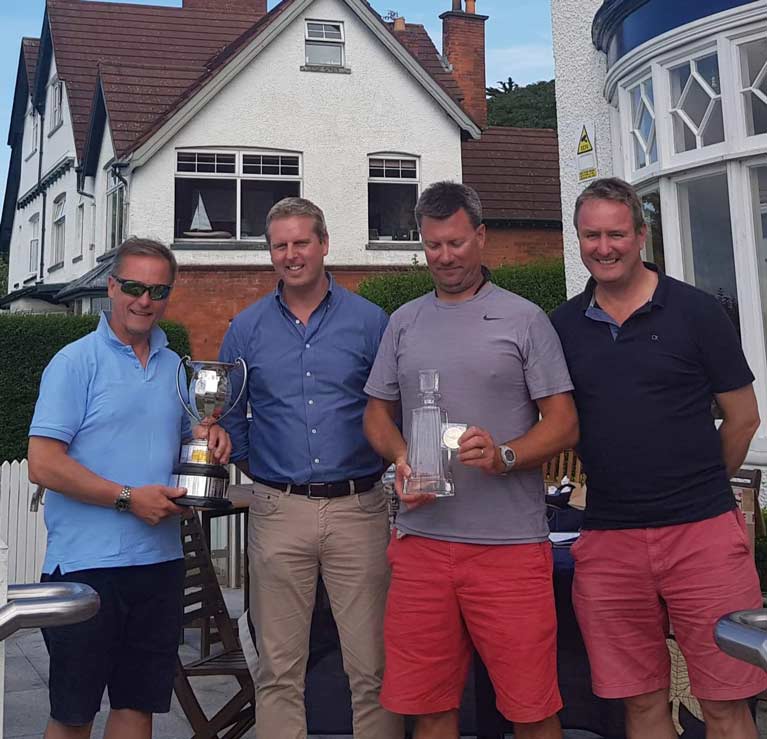
- 2nd Femme Fatale, Vincent Delaney and Joe O'Byrne with Noel also crewing.
- 3rd Outlaw, Ian Travers and Keith O'Riordan.
- 4th Maximus, Peter Wallace and Martin Weatherstone.
- 5th Inshallah, David Eccles and Phil Hutchinson



Article by Martin Weatherstone. Photos by Lindsay Nolan and Martin Weatherstone
The Volvo Dun Laoghaire Regatta takes place every two years, and each edition seems to grow both in status and in the number of boats competing. Between 11-14 July 500 boats competed in 34 classes. Did any of the classes stand out beyond the others?
The Black sails of Cruiser 1 Class were distinctive. The striped topsails of the Howth 17 foot one design encouraged the viewer to seek out an ice-cream stall. Some of the Seabird half-raters and Trearddur Bay Myths and the Classic Keelboats sported coloured sails, but the mace coloured sailed of the Squibs made them a distinctive entire fleet. On Thursday Squibs raced on the windward-leeward Centre course. In light winds, the recently acquired ‘Crackertoo’ sailed by Jeff Kay from Howth won by a good margin. Could he dominate the series to become the ‘Boat of the Regatta’?
On an overcast, Friday Squibs moved to the South Course which utilised the permanent Dublin Bay marks. ‘The Backstop’ sailed by Jill Fleming and Vincent Delany dominated the day with three first places in an 18-20 knot wind.
On a sunny Saturday with the light northerly winds on the windward-leeward North Course Rupert and Rory Westrup in ‘Sidewinder’ swopping helm and crewing positions as the race progressed won the first race, ‘The Backstop’ won race two, and ‘Sidewinder’ won race three to show her aspiration to win the series.
On Sunday there was a fading breeze, resulting in only one race being sailed on the ‘South Course’. This time ‘The Backstop’ held the lead from beginning to end to win the 8 race series with 9 points, compared with ‘Sidewinder’ on 12 points and ‘Crackertoo’ on 26 points.
Oh to be in Kinsale on a sunny Saturday with a breeze watching the wonderfully named Fagin, Outlaw, Slipstream, Allegro, Nimble and Kanaloa zipping around offshore marks battling like gladiators in Squibs for best positions at windward and leeward buoys, ducking and diving under the eagle eye of Race Officer Tony Small and his team aboard Destiny who got three races in… what a great first day reports Dave O'Sullivan.
The Championships was sponsored by Fusco Artisan, CH Marine and Mamuko.
Sunday turned out to be tougher for all with an overcast start followed by a sea mist later. Three races were once again sailed over a long day with boats finally alongside at 1600 with a crane awaiting to lift visitors ashore.
The nineteen boat fleet saw great competition with only four points separating first and fourth in the end after a discard.
Gold Fleet Results
Fagin (Royal NIYC – G. Patterson & R .Nolan) were overall winners by one point to Outlaw (Kinsale YC – I. Travers & K. O’Riordan) with Slipstream (Killyeagh YC – R. Marshall & B. Kelly) third, just ahead of Allegro (Kinsale YC – C. Dunne & F. Ward).
Silver Fleet Results
First place went to Sensation (Kinsale YC - B. & D. Cudmore) with Nebulette (Kinsale YC - M. Barry & L. Bond) second and Flora (Kinsale YC - B. Nash & D. Ross) third.
All agreed that it was a great test run for the Squib Nationals due to be held in Kinsale in late June 2020
Results here
Kinsale Yacht Club's Colm Dunne and Rob Gill are lying in third place overall in Torquay in Allegro in UK Squib Nationals after two races.
Dublin Bay's Jill Fleming and Vincent Delany finished 10th in race 2 in a fleet of 57 at the Royal Torbay hosted event.
Results are here
Bumper Entry for Squib Easterns at Howth Yacht Club
Howth Yacht Club hosted nineteen boats for the Squib Eastern Championships sponsored by Provident CRM last weekend writes Ronan MacDonell, HYC Squib Class Captain.
The event was run alongside the J24 Easterns which made for a busy clubhouse. While the weather played ball for the most part, wind conditions did offer a stern test for the race management team, ably led by Derek Bothwell. We had a series of shifts on Saturday which caused delays but the fleets were very grateful that the race management team were patient.
As Afloat reported previously, the Squibs sailed trapezoid courses for the weekend which was a change from the normal windward/leeward. Crews felt it the most as there was a lot of kite work over both days. We completed five races.
Race 1 got away clean and was dominated by Inshallah (Dave Eccles and Michael Wright). Volante (Simon Watson & Jordy Winters) took 2nd which was a great result for them, followed by Quickstep (Gordon Patterson and Ross Nolan).
After a delay, Race 2 got underway with a much-changed wind direction. There was a strong ebb now flowing and the Squib fleet was jumpy. We pushed the line and ended up with two recalls. Derek was forced to whip out the U Flag, followed by the Black Flag, which claimed three deserving victims. Game over for them! There was a robust tussle for the race win finally claimed by Outlaw (Ian Travers and Keith O’Riordan). Allegro (Collie Dunne and Fiona Ward) and Quickstep completed the podium positions.
Within minutes of the completion of the second race, Race 3 was in sequence, with everyone starting to look forward to a beer after a long day on the water. A Howth boat Tears in Heaven sailed by Peter Wallace and Martin Weatherstone burst out of the blocks and led from the traps to the winning post. Peter couldn’t wait to get to his usual tipple of “Howth Gin and Slimline”. Inshallah and Allegro made up the podium and we all faced a robust sail back to the marina.
The weather on Sunday was as good as it has been on the East coast of late. Light conditions with frequent sunny spells. Race 4 started in a fickle breeze which died off considerably downwind. The leading boats got around the bottom mark before the worst of the lull. The calm lasted about 10 minutes and soon there was breeze enough to get us upwind again. The race management team had the experience to shorten us up and tick Race 4 as “Done”. The race was won by Prodigal followed by Quickstep and Firecracker (Stephen Bridges and Kyle, Killyleagh YC).
A brief pause ensued before Race 5 got underway. The increasing breeze brought with it a modified direction, so the mark layers were busy again. The wind remained fickle at times, so tidal flows made the downwind legs tricky and then it steadied again to get us home. Outlaw got the gun followed by Periquin (Noel Colclough and Vincent Delaney) followed by Quickstep.
Congratulations to Gordon Patterson and Ross Nolan taking the Championship trophy back to Royal North of Ireland YC.
The Silver fleet was won by 3point9 Emmet Dalton and Peter Malone from HYC (Peter in his first Squib event!). Howth was represented by 9 boats, one of which was sailed by a crew from RNIYC. It is the best Howth representation at a regionals for quite a while. Results did not go our way but the positive is the re-emergence of the fleet on its 40th Anniversary in HYC. After a few years off the circuit, we will need a little time to get back up to speed!!
The event was awarded Silver Level Certification by Sailors For The Sea. The Sailors For The Sea Award for Sustainability went to Noel Colclough for retrieving more plastic from the sea than any other competitor.
Full Results here
This ever-popular Squib Championship hosted by Howth Yacht Club was supported by a somewhat unusual list of competitors, firstly Peter Wallace, current Irish Squib Champion’s Toy for the Boys broke free from it’s moorings and went up on the rocks at Belfast Lough three days before the event, secondly, Gordon Patterson couldn’t make up his mind which of his two boats was fastest, so he brought the hull of Quickstep III and sails from former 1994 UK Championship winner Fagin. Other unfamiliar boats included Outlaw which has lost its colourful paint job and in order to be inconspicuous on starting lines has returned to British Standard off-white.
There was an entry of nineteen boats, seven from the home club where the revived Squib fleet is growing rapidly, four hot boats from the Royal North of Ireland YC on Belfast Lough, three from Killyleagh Y.C. on Strangford Lough, two from Kinsale, and one from Kilbarrack S.C where the average water depth is about 300mm., one from Lough Derg Y.C. and one from the Royal St George Y.C.
Various weather forecasts suggested both easterly and westerly winds which were to back/ veer to the south. Forecasters seemed unsure about the strength of the wind but they knew that it would never reach gale force.
Race one which was held in westerly winds of Force two with flat water and strong tides was won by former Champion David Eccles in Inshallagh, followed by Simon Watson in Volante and Gordon Patterson and Ross Nolan in Quickstep III third. With northern boats taking the top three places, was this to be the pattern, yet again, for the championship.
Race two in similar conditions after the wind swung towards the south-west was won by Ian Travers in Outlaw, followed by Colm Dunne and Fiona Ward in the beautiful Allegro, boat boats from Kinsale, venue for the UK and Irish Squib Nationals next year.
The wind clocked around over a period of more than an hour from 250, to 180 and settled at about 150 degrees. It takes a patient race officer team to wait for the wind to settle to a championship standard. In the third race Peter Wallace and Martin Weatherstone were coming to terms with the borrowed Tears in Heaven which won the third race with their own Hyde sails from Toy for the Boys from Inshallagh and Allegro.
Overnight the results brought up some surprises due to the number of ‘U’ flag offenders, with Inshallagh in first place, Quickstep second and Noel Colclough’s consistent Periquin third.
On Sunday strong winds were expected from the south- but they never came. The competitors had a repeat of the previous days Force 2 winds which again backed all day. In race four the wind fell away completely and on a shortened course, was won by Greg Bell’s Prodigal crewed by Squib veteran Fred Campbell, Quickstep was second and Steve Bridges’ Firecracker third. At this point each race had a different winner.
The final race was won by Outlaw, with Periquin second and Quickstep III. Quickstep III had done enough to win the championship.
Download results below
Squibs’ Golden Jubilee Will Get Full Treatment at Cultra
The 19ft–Squib keelboat is quite often raced with ferocious competitiveness which is almost frightening for those of us who bought them many years ago as handy little boats which worked as an ideal family day-sailer while providing some club One-Design racing as a useful option writes W M Nixon.
The alleged story of their origins has a certain irresistible charm. It’s said that in 1967 or thereabouts, the local GP in Burnham-on-Crouch - that total sailing place in among the many rivers and creeks of Essex - had the complete rig for an Enterprise Dinghy, but no hull to go with it.
However, having decided that his dinghy-sailing days were over, the doctor was yarning down the pub with the local small boat designer Oliver Lee, and the upshot of it was that Lee agreed to design a smaller version of his proven Ajax 23 in order to create a comfortable little keelboat which could use that redundant Enterprise rig.
You wouldn’t dream of measuring up an actual Enterprise rig against what finally emerged on the Squib, for fear of blowing that charming myth out of the water. But in any case, when the new boat soon proved so popular that classes started developing almost immediately, they were using distinctive sails in a tanned fabric such as you see on old gaffers, as it’s said some sailmaker had mistakenly over-ordered a stock of the stuff, so they were very competitively priced.
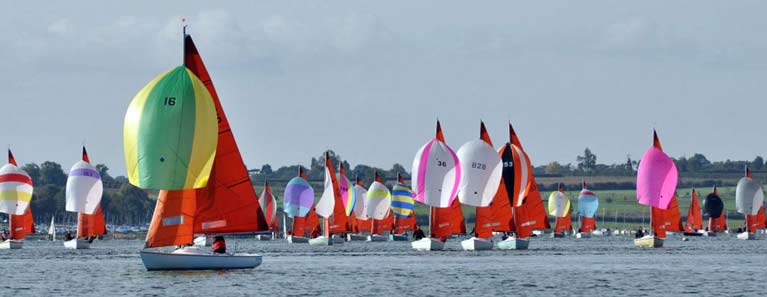 Squibs in their dozens…..ever since the design appeared, there have been those who wanted a bigger spinnaker, while others want to change the sail colour, but the Squib remains her own very distinctive self
Squibs in their dozens…..ever since the design appeared, there have been those who wanted a bigger spinnaker, while others want to change the sail colour, but the Squib remains her own very distinctive self
The odd boat turned up here and there in Ireland – there’s a rumour one of the first was seen in West Cork – but the first Club to seriously adopt the class was Royal North of Ireland YC at Cultra on Belfast Lough. And they certainly didn’t let the grass grow under their feet – they’d Squibs racing in significant numbers by 1969, and in the years since, they’ve been far and away the most frequent winners of the Irish championship.
Admittedly it was when Howth hosted the British and Irish Championship in 1995 that the Squibs achieved a hundred boats-plus on the starting line for the first time, but down the ages it is the Cultra sailors who have most assiduously kept the faith, and this year they’re celebrating the Golden Jubilee of their fleet with a turbo-powered three day event for the 2019 Irish Nationals at Cultra on August 2nd to 4th, details here
The Squib is so broadly spread all over Ireland that we can get typical photos from many centres showing their versatility, but my favourite continues to be one taken at Dromineer on Lough Derg where the little boats are revelling in Autumn sailing at its best.
It now has added interest, as it shows a classic Lough Derg shoreline. Yachting historian Vincent Delany was referring to this background when he commented that the recently-sold Montagu Dawson painting of International 6 Metres supposedly racing on Lough Derg featured a shoreline which no Lough Derg sailor would recognise. Enough said.
How Slack Can You Go With a Forestay & Still Get Benefit?
A long time ago when I brought the first very second-hand Squib to Howth Yacht Club in 1979, things were different writes WM Nixon. After all, it was forty years ago (there’s another local class anniversary for you), and I’d spent the 1970s either racing offshore under IOR as it then was, with 150% genoas, or cruising in good old-fashioned boats where a taut forestay was likewise de rigeur.
Sometimes crews were so keen to straighten the forestay on hot offshore racers that they found their over-use of the hydraulic backstay tensioner was slowly driving the foot of the mast through the bottom of the boat. As for narrowing the slot between jib and mainsail, it was thought to look scruffy - “I don’t like the cut of his jib” had real meaning.
So it was interesting to note the recent North Sails piece on Afloat.ie about the benefit of giving the forestay a little bit of sag to help performance in light airs. Just how much sag you should give presumably depends on many factors, but on boats where the headsail is really only a jib, such as the Etchells 22 or Squib, it seems that anything goes.
Certainly, I felt distinctly prehistoric over the years, in becoming aware of the way Squibs were experimenting with slack forestays and the clew hauled well inboard. It looked plain wrong. But it worked. That said, in the quaint photo of 40 years ago where I’m helming in considerable comfort thanks to a marvellous crew in Ian Jackson, who could sit right out ramrod straight for as long as was needed, there certainly were other Squibs out racing, but there doesn’t seem to be one in front of us…….
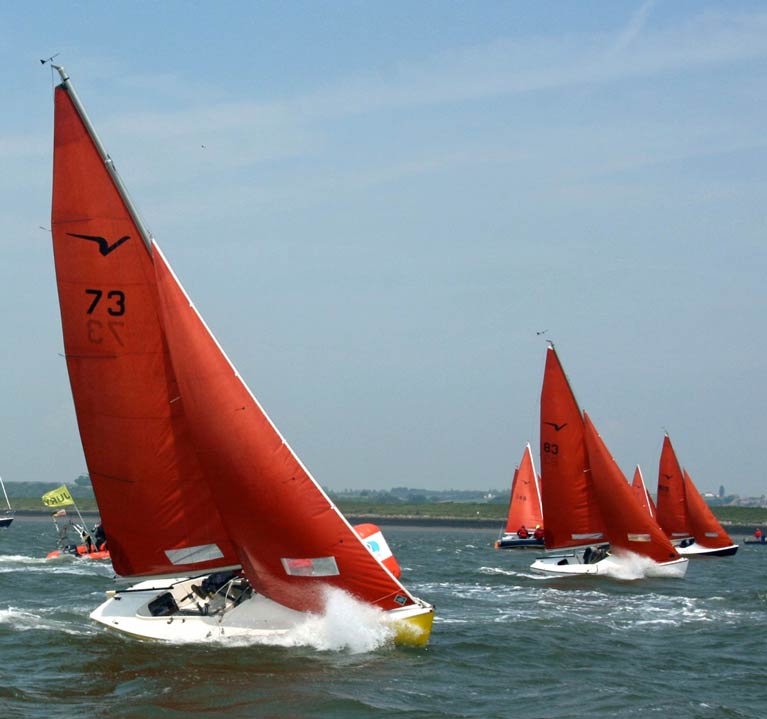 Do you like the cut of his jib? Squib jib trim as it is today
Do you like the cut of his jib? Squib jib trim as it is today
Squib Fleet To Support Fun Fridays at the Royal St George Yacht Club
At the recent Dublin Bay Squib fleet AGM which was well attended by active members, the following decisions were taken:
- Members of the Squib fleet will ensure that the turn out of Squibs at Dublin Bay Sailing Club Thursday and Saturday races will be superior to 2018.
- It is expected that Allsorts and Karma will join the active fleet for club racing.
- Class Captain Noel Colclough and his team will be organising crew coaching at the beginning of the season.
- The Squib fleet will be supporting the Fun Fridays at the Royal St George Yacht Club.
- The Dublin Bay Squib Fleet will endeavour to find new owners for any boats currently for sale.


























